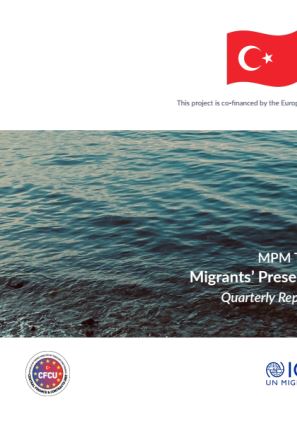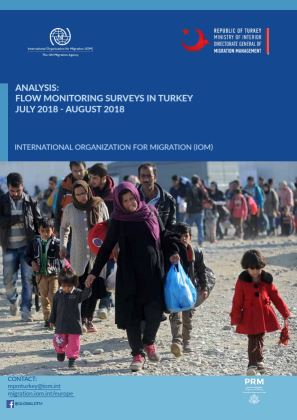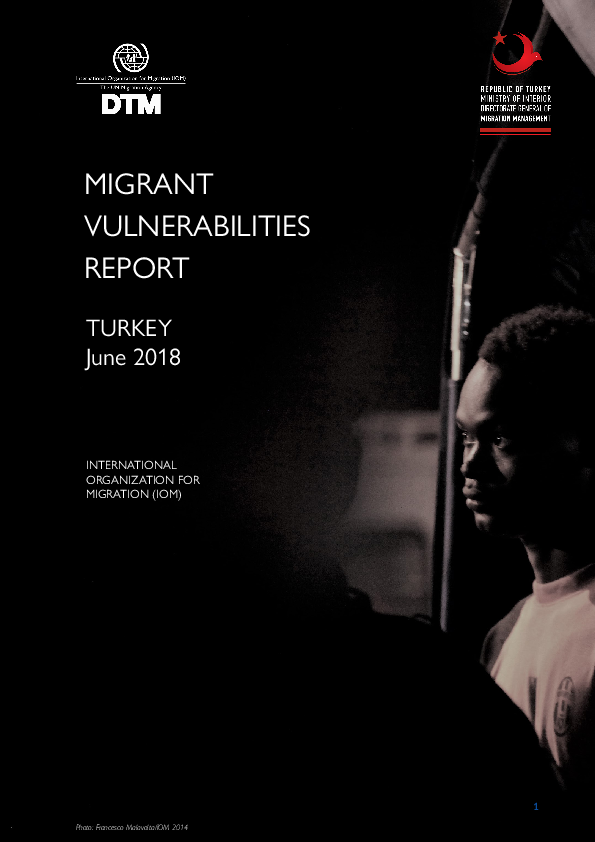-
Countries
-
Data and Analysis
-
Special Focus
-
Crisis Responses
Flow Monitoring Survey
Country
Title Standard
Turkey — Flow Monitoring Survey (April – May 2017)
Operation
Contact
DTM Turkey, dtmturkey@iom.int
Type
Domain
Confidential

Contact
DTM Turkey, DTMTurkey@iom.int
Language
English
Location
Republic of Türkiye
Period Covered
Jul 01 2020
Sep 30 2020
Activity
- Flow Monitoring Survey
- Flow Monitoring
- Migrants presence
According to the latest available figures from the Turkish Directorate General of Migration Management (DGMM), there are more than 4.6 million foreign nationals present in Turkish territory, 3.6 million of whom are seeking international protection. Most are Syrians (3,624,941 individuals) who are granted temporary protection status. In addition, international protection applicants from countries including Afghanistan, the Islamic Republic of Iran and Iraq constitute another group of foreign nationals. According to DGMM, as of end of 2019, there were 56,417 international protection applicants present in Turkey1. Since June 2020 the number of Syrians residing in camps has decreased by 3,110.
In addition, there are 918,202 foreign nationals present in Turkey holding residency permits including humanitarian residence holders. The exact number of the humanitarian residence holders is unknown, but it is estimated that there are a few thousand humanitarian resident holders.

Contact
DTM Turkey, DTMTurkey@iom.int
Language
English
Location
Republic of Türkiye
Period Covered
Jul 01 2020
Jul 31 2020
Activity
- Flow Monitoring Survey
- Flow Monitoring
- Migrants presence
- Mobility Tracking
According to the latest available figures from the Turkish Directorate General of Migration Management (DGMM), there are more than 4.6* million foreign nationals present in Turkish territory, 3.6* million of whom are seeking international protection. Most are Syrians (3,591,892* individuals) who are granted temporary protection status. In addition, international protection applicants from countries including Afghanistan, the Islamic Republic of Iran and Iraq constitute another group of foreign nationals. According to DGMM, as of end of 2019, there were 56,417* international protection applicants present in Turkey. The number of foreign nationals has decreased by 88,976 in comparison to June 2019 (3.7 million foreign nationals). In addition, there are 1,008,754* foreign nationals present in Turkey holding residency permits, including humanitarian residency holders. Compared to June 2019, this is an increase of 449 individuals. The exact number of humanitarian residency holders is unknown, but it is estimated that there are more than several thousand humanitarian residency permit holders.
Turkey’s temporary protection regime grants the 3,591,892* Syrian nationals the right to legally stay in Turkey as well as obtain some level of access to basic services. The vast majority - 3,529,239* individuals – live outside of formal camps, known as temporary accommodation centers, thus primarily residing across the Turkish border provinces of Hatay, Adana and Kilis. As such, only 62,653* Syrians live in formal camps, the majority of which are located close to the Syrian border. Compared to June 2019 when 13 temporary accommodation centers were hosting migrants in Turkey, only seven remain operational with six no longer in service. As a result, 46,079 fewer Syrians currently reside in the centers.

Contact
DTMTurkey@iom.int
Language
English
Location
Republic of Türkiye
Period Covered
Jul 01 2018
Aug 31 2018
Activity
- Survey
- Flow Monitoring Survey
Migrants Presence Monitoring (MPM) team in Turkey conducted 3,043 surveys with Afghan, Iranian, Syrian and Iraqi nationals between July and August 2018. More than half of the respondents from Afghanistan, the Islamic Republic of Iran and Syrian Arab Republic were adult males, while 53% of respondents from Iraq were adult females. Over half of all respondents reported they were married. The majority of respondents from the Syrian Arab Republic (96%) reported Turkey as their intended destination at the time of departure from their coutnry of departure or habitual residence, followed by respondents from Iraq (85%) and Afghanistan (75%). The lowest share was among nationals of the Islamic Republic of Iran (22%). Additionally, the share of respondents who reported Turkey as the intended destination country at the time of the itnerview decreased among the respondents of all nationalities.

Contact
DTMTurkey@iom.int
Language
English
Location
Republic of Türkiye
Period Covered
Oct 01 2018
Dec 31 2018
Activity
- Flow Monitoring Survey
- Mobility Tracking
According to the latest available figures frmo the Turkish Directorate General of Migration Management (DGMM) there are currently an estimated 3,9 million foreign nationals present in Turkish territoriy seeking international protection. Most are Syrian nationals (3,622,366) under temporary protection and another large group are asylum seekers and refugees (368,230) from countries including Iraq, Afghanistan, the Islamic Republic of Iran and Somalia.

Contact
DTM Turkey, dtmturkey@iom.int
Language
English
Location
Republic of Türkiye
Period Covered
Apr 01 2018
Jun 30 2018
Activity
- Survey
- Flow Monitoring Survey
- Return Intention
- Flow Monitoring
- Baseline Assessment
According to the findings from the Baseline report, across the ten provinces assessed, the Baseline 2 recorded presence of 195,849 migrants, 14 per cent less than the 229,419 recorded in the Baseline 1. Migrants and refugees tend to move to the areas with a higher presence of migrants mainly related to the provision of humanitarian/government services. Some of the information, revelaed a phenomenon of seasonal migration.

Contact
DTM Turkey, dtmturkey@iom.int
Language
English
Location
Republic of Türkiye
Period Covered
Dec 01 2017
Feb 28 2018
Activity
- Survey
- Flow Monitoring Survey
- Flow Monitoring
Analysis focuses on the set of vulnerability indicators included in the Flow Monitoring Surveys implemented in Turkey. DTM/MPM team interviewed 3,173 surveys in 14 provinces between December 2017 and February 2018 . Male respondents were more likely than female respondents to report having experienced situation described in one of the four vulnerability indicators (worked/performed activities without getting the expected payment, been forced to work, been forced or coerced into a marriage and been kept at certain location against their will). One third of male Afghan nationals and one third of amle Iranian nationals answered "yes" to at least one of the four mentioned indicators.